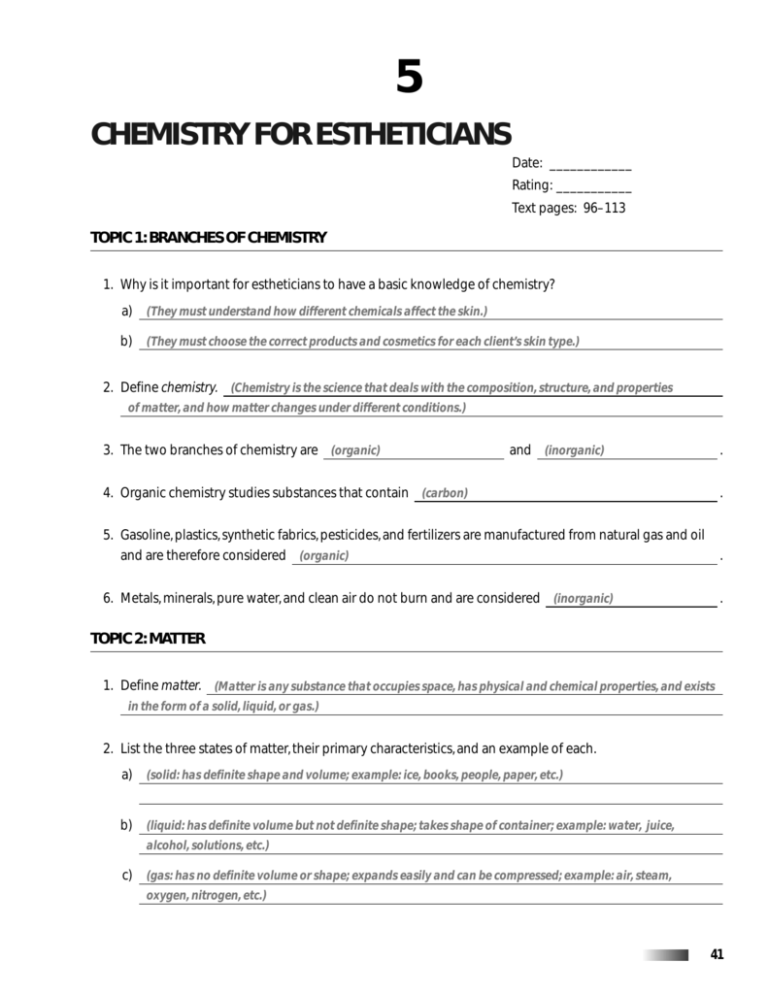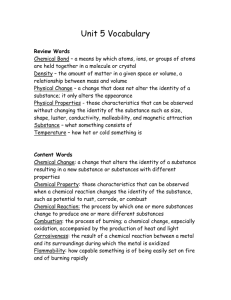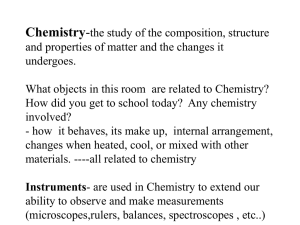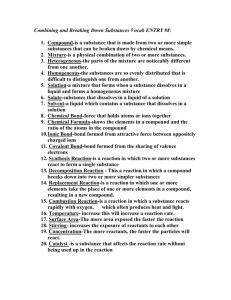CHEMISTRY FOR ESTHETICIANS
advertisement

5 CHEMISTRY FOR ESTHETICIANS Date: ____________ Rating: ___________ Text pages: 96–113 TOPIC 1: BRANCHES OF CHEMISTRY 1. Why is it important for estheticians to have a basic knowledge of chemistry? a) (They must understand how different chemicals affect the skin.) b) (They must choose the correct products and cosmetics for each client’s skin type.) 2. Define chemistry. (Chemistry is the science that deals with the composition, structure, and properties of matter, and how matter changes under different conditions.) 3. The two branches of chemistry are (organic) and (inorganic) . 4. Organic chemistry studies substances that contain (carbon) . 5. Gasoline, plastics, synthetic fabrics, pesticides, and fertilizers are manufactured from natural gas and oil and are therefore considered (organic) . 6. Metals, minerals, pure water, and clean air do not burn and are considered (inorganic) . TOPIC 2: MATTER 1. Define matter. (Matter is any substance that occupies space, has physical and chemical properties, and exists in the form of a solid, liquid, or gas.) 2. List the three states of matter, their primary characteristics, and an example of each. a) (solid: has definite shape and volume; example: ice, books, people, paper, etc.) b) (liquid: has definite volume but not definite shape; takes shape of container; example: water, juice, alcohol, solutions, etc.) c) (gas: has no definite volume or shape; expands easily and can be compressed; example: air, steam, oxygen, nitrogen, etc.) 41 42 FUNDAMENTALS FOR ESTHETICIANS WORKBOOK 3. What is an element? (The simplest form of matter; it cannot be broken down into a simpler substance without loss of identity.) 4. How many naturally occurring elements are there? (about 90) 5. Elements are made up of structural units called (atoms) . 6. Name the smaller particles that make up atoms and the electrical charge of each: a) (protons—positive electrical charge) b) (neutrons—neutral charge) c) (electrons—negative charge) 7. Joining two or more atoms chemically creates a (molecule) . 8. Elemental molecules contain two or more atoms of the same element that are united (chemically) . 9. Chemical combinations of two or more atoms of different elements are (compound molecules) . 10. Define compound. (A compound is a combination of two or more atoms of different elements united chemically with a fixed chemical composition, definite proportions, and distinct properties.) 11. What is the chemical composition of water? (two atoms of hydrogen and one atom of oxygen: H2O) 12. Define mixture. (A mixture is a combination of two or more substances united physically, not chemically, without a fixed composition and in any proportions.) 13. Color, weight, melting point, and odor are examples of (physical) properties. 14. When wood is burned and turns into ash, there is a change in its (chemical) properties. 15. Define these terms and give an example of each: a) physical change: (change in the form or physical properties of a substance without the formation of a new substance; example: ice melting into water, water turning into steam, etc.) b) chemical change: (change in the chemical composition of a substance, in which a new substance or substances are formed having properties different from the original; example: oxidation, etc.) CHAPTER 5 CHEMISTRY FOR ESTHETICIANS 43 16. Identify the following elements, compounds, or mixtures in the spaces provided: a) (air) gaseous mixture that makes up the earth’s atmosphere b) (oxygen) most abundant element found both free and in compounds c) (hydrogen peroxide) colorless liquid that is a compound of hydrogen and oxygen d) (nitrogen) gaseous element that comprises about four-fifths of the air e) (water) most abundant of all substances; comprising about 75 percent of the earth’s surface f ) (hydrogen) lightest element known; flammable and explosive when mixed with air 17. Oxygen combines with many other elements to form compounds called (oxides) 18. . is found mostly in the form of ammonia and nitrates. (Nitrogen) 19. One of the important chemical characteristics of oxygen is its ability to support (combustion) . 20. The most commonly used ingredient in cosmetics is (water) . 21. A 10 percent volume solution of (hydrogen peroxide) has antiseptic properties. 22. What is pH? (The pH [potential hydrogen] of a substance is its relative degree of acidity or alkalinity.) 23. Name the characteristics of acids and alkalis/bases: a) acids: (substances that have a pH below 7.0, taste sour, and turn litmus paper from blue to red) b) alkalis or bases: (substances that have a pH above 7.0, taste bitter, and turn litmus paper from red to blue) 24. What is the neutral pH range? (6.5 to 7.5) 25. A pH of 6 is (10) times more alkaline than a pH of 5, and (100) times more alkaline than a pH of 4. 26. What are the functions of the acid mantle? (The acid mantle is a protective barrier against certain forms of bacteria and microorganisms, and it may be a factor in the natural skin shedding and renewal process.) 27. What is the pH of the acid mantle? (between 4.5 and 6.2) 44 28. FUNDAMENTALS FOR ESTHETICIANS WORKBOOK may result if the skin is exposed to low or high pH. (Inflammation) 29. When equal proportions of an acid and an alkali are combined, they neutralize each other and form and a salt. (water) 30. Define the following terms: a) oxidation: (chemical reaction that combines an element or compound with oxygen to produce an oxide; also the removal of hydrogen) b) reduction: (chemical reaction in which oxygen is subtracted from, or hydrogen is added to, a substance) c) combustion: (rapid oxidation of any substance, accompanied by the production of heat and light) d) redox: (contraction for reduction-oxidation, in which the oxidizing agent is reduced and the reducing agent is oxidized) 31. An oxidizing agent releases (oxygen) 32. Oxidation and (reduction) . always occur at the same time. 33. Solutions, suspensions, and emulsions are all kinds of (physical mixtures) . 34. Identify the following substances in the spaces provided: a) (solvent) substance, usually liquid, that dissolves another substance to form a solution, with no change in chemical composition b) (suspension) state in which solid particles are distributed throughout a liquid medium c) (solution) blended mixture of two or more solids, liquids, or gaseous substances d) (emulsion) mixture of two or more immiscible substances united with the aid of a binder or emulsifier e) (solute) the dissolved substance in a solution f ) (miscible liquids) 35. (Water) liquids that are mutually soluble; can be mixed with each other in any proportion without separating is a universal solvent. CHAPTER 5 CHEMISTRY FOR ESTHETICIANS 45 36. Define immiscible liquids and give an example. (Immiscible liquids are not capable of being mixed; example: water and oil.) 37. List three characteristics of solutions: a) (contain particles that are invisible to the naked eye) b) (usually transparent) c) (do not separate on standing) 38. List three characteristics of suspensions: a) (contain larger particles that are generally visible to the naked eye but not large enough to settle to the bottom) b) (usually not transparent) c) (have a tendency to separate over time) 39. What does the term emulsify mean? (It means “to form an emulsion,” a suspension of one liquid in another.) 40. What are the substances that allow oil and water to mix? (surfactants) 41. Name and describe the two parts of a surfactant molecule. a) (hydrophilic head: water-loving; dissolves in water) b) (lipophilic tail: oil-loving; dissolves in oil) 42. Match each of the following substances with the type of matter it represents. compound element emulsion solution a) (compound) pure water b) (solution) salt water c) (element) carbon d) (emulsion) shampoo e) (suspension) calamine lotion suspension 46 FUNDAMENTALS FOR ESTHETICIANS WORKBOOK 43. List and define the two types of emulsions used in cosmetics. a) (oil in water or O/W: oil droplets suspended in a water base) b) (water in oil or W/O: droplets of water suspended in an oil base) 44. O/W emulsions usually contain more (water) than (oil) . 45. What is one advantage of O/W emulsions? (They are easily rinsed away with water.) 46. Give examples of O/W emulsions. (Moisturizing lotions, cleansing lotions, suntan lotions.) 47. Give examples of W/O emulsions. (Cleansing creams, cold creams, night creams, massage creams, baby creams, hair grooming creams.) 48. If a cosmetic emulsion product separates, it should be (discarded) .








